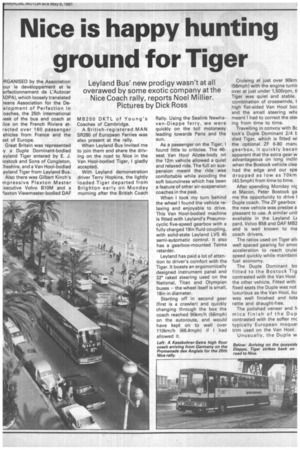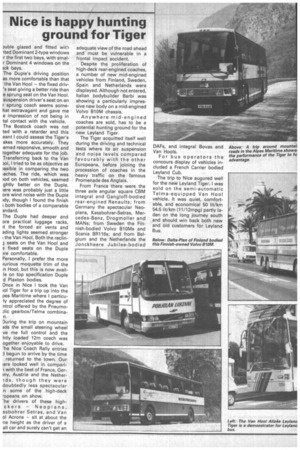Nice is happy hunting ground for Tiger
Page 33

Page 34

If you've noticed an error in this article please click here to report it so we can fix it.
Leyland Bus' new prodigy wasn't at all overawed by some exotic company at the Nice Coach rally, reports Noel Millier. Pictures by Dick Ross
RGANISED by the Association ur le developpement et le erfectionnement de L'Autocar DPA), which loosely translated eans Association for the Deelopment of Perfection in 'oaches, the 25th international reek of the bus and coach at lice on the French Riviera atracted over 160 passenger ehicles from France and the ast of Europe.
Great Britain was represented a Duple Dominant-bodied eyland Tiger entered by E. J. 1ostock and Sons of Congleton, :heshire, and a Van Hool-bodied pyland Tiger from Leyland Bus. Also there was Gilbert Kinch's mpressive Plaxton Master xecutive Volvo B1OM and a 'laxton Viewmaster-bodied OAF MB2 0 0 DKTL of Young's Coaches of Cambridge.
A British-registered MAN SR280 of European Ferries was also present at the rally.
When Leyland Bus invited me to join them and share the driving on the road to Nice in the Van Hool-bodied Tiger, I gladly accepted.
With Leyland demonstration driver Terry Hopkins, the lightly loaded Tiger departed from Brighton early on Monday morning after the British Coach Rally. Using the Sealink Newhaven-Dieppe ferry, we were quickly on the toll motorway leading towards Paris and the sun.
As a passenger on the Tiger, I found little to criticise. The 46seat Van Hool Alizee-body on the 12m vehicle allowed a quiet and relaxed ride. The full air suspension meant the ride was comfortable while avoiding the soft bounciness which has been a feature of other air-suspension coaches in the past.
When I took my turn behind the wheel I found the vehicle relaxing and enjoyable to drive. This Van Hool-bodied machine is fitted with Leyland's Pneumocyclic five-speed gearbox with a fully charged 19in fluid coupling, with solid-state Leyland LVS 45 semi-automatic control. It also has a gearbox-mounted Telma retarder.
Leyland has paid a lot of attention to driver's comfort with the Tiger. It boasts an ergonomically designed instrument panel and 32° raked steering used on the National, Titan and Olympian buses — the wheel itself is small, 18in in diameter.
Starting off in second gear (first is a crawler) and quickly changing through the box the coach reached 90km/h (56mph) on the autoroute, and would have kept on to well over 110km/h (68.4mph) if I had allowed it. Cruising at just over 90km (56mph) with the engine turnir over at just under 1,500rpm, tl Tiger was quiet and stable. combination of crosswinds, t high flat-sided Van Hool boc and the small steering whE meant I had to correct the ster ing from time to time.
Travelling in convoy with Bc tock's Duple Dominant 2/4 h died Tiger, which is fitted wi the optional ZF 6-80 mani. gearbox, it quickly becan apparent that the extra gear w advantageous on long inclin when the Bostock vehicle clea had the edge and our spe dropped as low as 70km (43.5mph) from time to time.
After spending Monday nic at Macon, Peter Bostock ga me the opportunity to drive Duple coach. The ZF gearbox the new vehicle was precise a pleasant to use. A similar unit available in the Leyland LE pard, Volvo 858 and DAF MB2 and is well known to ma coach drivers.
The ratios used on Tiger alb well spaced gearing for smoc acceleration to reach cruisi speed quickly while maintaini fuel economy.
The Duple Dominant bo fitted to the Bostock Tig contrasted with the Van Hool the other vehicle. Fitted with fixed seats the Duple was not luxurious as the Van Hool, bu was well finished and tota rattle and draught-free.
The polished veneer and fc mica finish of the Dup contrasted with the softer mc typically European moque1 trim used on the Van Hool.
Unusually, the Duple w
)uble glazed and fitted with -lied Dominant 2-type windows the first two bays, with smalr Dominant 4 windows on the 3ck bays.
The Duple's driving position as more comfortable than that 'the Van Hool — the fixed driv's seat giving a better ride than e sprung seat on the Van Hool. suspension driver's seat on an r sprung coach seems somehat extravagant and gave me e impression of not being in tal contact with the vehicle. The Bostock coach was not ted with a retarder and this eant I could assess the Tiger's akes more accurately. They emed responsive, smooth and together adequate for the job. Transferring back to the Van )01, I tried to be as objective as )ssible in comparing the two ■ aches. The ride, which was )od on both vehicles, seemed ghtly better on the Duple. iere was probably just a little ore wind noise with the Duple idy, though I found the finish I both bodies of a comparable 3ndard.
The Duple had deeper and ore practical luggage racks, it the forced air vents and ading lights seemed stronger the Van Hool. Both the recling seats on the Van Hool and a fixed seats on the Duple 3re comfortable.
Personally, I prefer the more Once in Nice I took the Van Tiger for a trip up into the pes Maritime where I particuly appreciated the degree of ntrol offered by the Pneumolic gearbox/Telma combinan. During the trip on mountain 3ds the small steering wheel ye me full control and the htly loaded 12m coach was ogether enjoyable to drive. The Nice Coach Rally entries begun to arrive by the time returned to the town. Our lers looked well in compariwith the best of France, Geriny, Austria and the Netherlds, though they were doubtedly less spectacular n some of the high-deck -opeans on show. The drivers of these highckers — Neoplans, ssbohrer Setras, and Van ol Acrons — sit at about the ne height as the driver of a all car and surely can't get an adequate view of the road ahead and must be vulnerable in a frontal impact accident. Despite the proliferation of high-deck rear-engined coaches, a number of new mid-engined vehicles from Finland, Sweden, Spain and Netherlands were displayed. Although not entered, Italian bodybuilder Barbi was showing a particularly impressive new body on a mid-engined Volvo B1OM chassis. Anywhere mid-engined coaches are sold, has to be a potential hunting ground for the new Leyland Tiger. The Tiger acquitted itself well during the driving and technical tests where its air suspension and noise levels compared favourably with the other Europeans, before joining the procession of coaches in the heavy traffic on the famous Promenade des Anglais. From France there were the three axle angular square CBM integral and Gangloff-bodied rear-engined Renaults; from Germany the spectacular Neoplans, Kassbohrer-Setras, Mercedes-Benz, Drogmoller and MANs; from • Sweden the Finnish-bodied Volvo B10Ms and Scania BR116s; and from Belgium and the Netherlands the Jonckheere Jubilee-bodied DAFs, and integral Bovas and Van Hools. For bus operators the concours display of vehicles included a French Carrier bodied Leyland Cub. The trip to Nice augured well for the new Leyland Tiger. I was sold on the semi-automatic Telma-equipped Van Hool vehicle. It was quiet, comfortable, and economical 50 lit/km 54.5 lit/km (11/12mpg) partly laden on the long journey south and should win back both new and old customers for Leyland Bus.
































































































































































